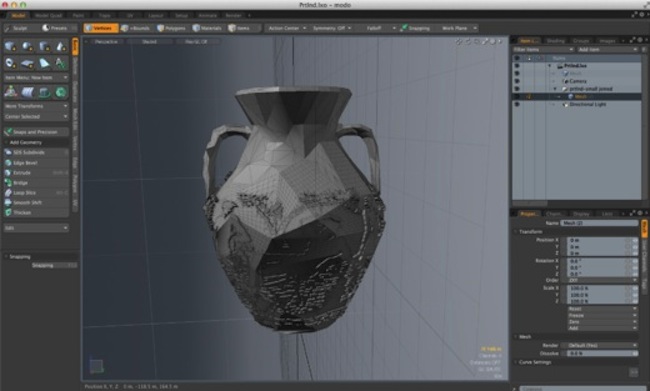The Internet is a place where we spend increasing amounts of time. We go there to talk to our friends, to play, to learn, and to explore. It’s a place where space and time become blurred and the actual, physical world mixes with the virtual. Google allows us to explore the world as time-travelers to the recent past, floating through streets on the other side of the world. Google also allows us to walk through galleries and museums and zoom in on the brush strokes of our favourite paintings. Why queue for the Uffizi when you can stroll through the empty galleries from the comfort of your armchair?
It is an extraordinary technical achievement, a very useful tool, but it’s not the real thing; you can’t smell the oil paint and you can’t quite walk all the way round the sculptures. It is a 2D representation of the real world.
Michael Eden made the Prtlnd Vase to explore these issues. His chose his subject carefully, creating a reproduction of the Portland Vase, an exquisite Roman glass vase that has fascinated generations and been the subject of numerous attempts to reproduce it. The most recognizable copies are by Josiah Wedgwood, the first of which was displayed in 1790, after four years of laborious trials. The Duke of Portland lent him the original, so that Wedgwood could study the details and produce an accurate ceramic copy.
Eden, on the other hand, only used visual information available from search engines. “My interpretation has been created from information and imagery freely available on the Internet. It is deliberately facetted and some of the original decoration is missing because I couldn’t ‘see’ it in enough detail,” stated Eden. As is common in his practice, this artwork was rendered using 3D software and manufactured by 3D printing; Eden refers to these advances in technology as “the Second Industrial Revolution,” which adds an additional twist to this remake.
So, the Prtlnd Vase represents the next chapter of the continuing story of the Portland vase, but seen through the filter of the Internet. It has been created to draw in the viewer and to question the relationship between the actual and the virtual.
Michael Eden was born in Blackburn, Lancashire in 1955 and is based in London. In 2008 he graduated from the Royal College of Art, London. He has exhibited extensively and his work can be found in many private collections as well as the following institutions: Crafts Council, London; Stoke-On-Trent Museum, Stoke-On-Trent; Nationalmuseum, Stockholm, Sweden; Carnegie Museum of Art, Pittsburgh; Cooper-Hewitt National Design Museum, New York; Museum of Fine Arts, Boston; and the Musée des Beaux-Arts, Montréal, Canada.
Above image: a 3D rendering by Michael Eden that was one step in the process of creating his Prtlnd Vase. Courtesy of the artist and Adrian Sassoon Gallery.


Michael Eden, Prtlnd Vase, 2012. Nylon with mineral coating. 11 3/4 inches high, Diameter 9 1/2 inches. Images courtesy of Adrian Sassoon Gallery.

Michael Eden at the British Museum, London standing in front their great treasure, the Portland Vase, a 1st century AD Roman glass example of cameo glass, the finest in existence. Part of its fame comes from its much-publicized conservation. Image courtesy of Adrian Sassoon Gallery.


Above are Portland Vases by Josiah Wedgwood. The black and white version was introduced in 1790; it was the first modern limited edition of a work of ceramic art and was made in Basaltware. The second, blue and white and far the more famous, was produced later and made in Jasperware.
Michael Eden explains his transition from studio potter to creating work with rapid prototyping and his Wedgewoodn’t Tureen project.
Michael Eden explains how the rapid prototyping process informs his work.
Read about the original Portland vase

Add your valued opinion to this post.